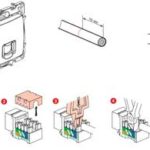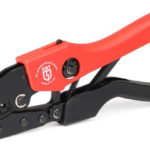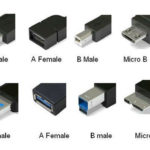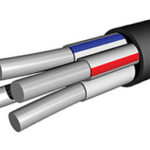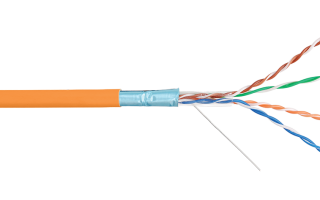A twisted pair is a pair of insulated conductors twisted together. This type of cable is also called RJ-45 or Ethernet 10/100, we will talk about the twisted pair crimping scheme with our own hands in the material.
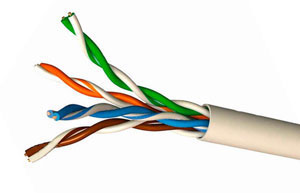
After laying the Internet cable, it is necessary to fix the connector at its end so that it can be connected. To do this, crimp the cable with a special tool. After that, you can connect it to the network card and configure the connection to the Internet. In the material, we will figure out how to connect a twisted pair cable to a power outlet and how to independently compress the wire into 4 and 8 cores.
Content
What is twisted pair
The name twisted pair is due to the fact that the cable has 8 copper conductors twisted in pairs with different colors.
Twisting is carried out in order to reduce the degree of influence of external electromagnetic interference and mutual interference in the process of signal transmission.
Using twisted pair, you can create a connection with a data transfer rate of up to 1 GB per second. To create a high-speed network, you must have a cable with 8 wires, that is, 4 twisted pairs. For this reason, it is recommended to crimp all 8 wires. But there are also cables provided for 4 cores.
Pinout diagrams
The twisted pair pinout assumes two types of connection:
- standard T568A;
- T568B standard.
For ease of understanding, you need to remember the following pinout color scheme: the first standard assumes white-orange and orange, the second - white-green and green.
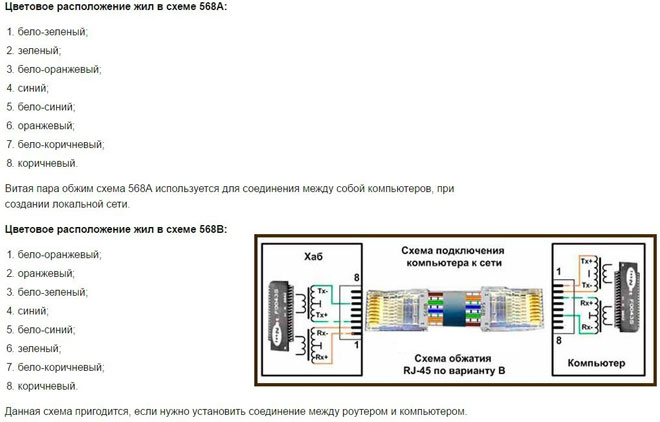
The second RJ45 crimping scheme is more popular, however, when forming an internal network, you can crimp using any of the indicated methods.
Crimping technology
Here is a step-by-step procedure for crimping an 8-wire cable:
- remove the insulation and strip the wire 3 cm;
- disconnect the wires so that they are located separately from each other;
- insert the wires into the connector;
- when inserting wires into the connector, be guided by the contact group. Standard crimping methods involve the arrangement of colors according to the scheme:
- white-orange;
- Orange;
- white-green;
- blue;
- white-blue;
- green;
- white-brown;
- brown;
- after inserting all the wires according to the diagram, it is necessary to check that they are inserted all the way. Further, with the correct connection, the Internet cable is crimped;
- a cable with a bare 3-centimeter end is cut, so that it is securely fixed in a stationary state;
- then the wires are inserted into the connector, and the whole thing is placed in the pliers.The design provides for the only correct position of the connector, so you will immediately understand the position for installation. Press to insert until it stops, after which the process is considered complete.
straight type
The direct crimp type is used to connect the network card port to network equipment (switch or hub):
- according to the EIA / TIA-568A standard: computer - switch, computer - hub;

- according to the EIA / TIA-568B standard, it is the most popular and assumes the scheme: Computer - switch, computer - hub.

cross type
The cross crimp type assumes that two network cards are connected directly to each other according to the color scheme shown. Suitable for creating 100/1000 Mbps speed, EIA/TIA-568B and EIA/TIA-568A standards are used.
Computer - computer, switch - switch, hub - hub.

It should be noted that when crimping a twisted pair, it is necessary to observe the minimum bending radius (8 external cable diameters). With a strong bend, external interference and interference to the signal may increase, and the sheath or screen of the cable may also be destroyed.
Four core cable
You can compress a twisted pair into 4 cores in the same way as 8 cores, the difference is only in the number of wires that are used to transfer data.
Instructions on how to crimp a 4-core cable for the Internet:
- 1,2,3 and 6 channels of the RJ45 connector are used. The first pair of cores is inserted into channels 1 and 2, the second pair - into channels 3 and 6. The procedure is performed on both sides of the cable;
- remove a few centimeters of insulation;
- unwind and straighten all strands;
- arrange them by color: white-orange, orange, white-green, green;
- with other colors, it is necessary to correctly hit the first and second pair in the corresponding channels indicated above;
- hold the RJ45 connector with the plastic retainer down;
- then do the same on the other end of the cable.
Using this manual, you can crimp the cable yourself and get a maximum data transfer rate of up to 100 Mbps.
Crimp without tools
You can crimp an 8-core twisted pair cable without special tools, but only with the help of the following items available in any home:
- using a conventional screwdriver, the RJ 45 connector is crimped;
- with a knife, you can strip the twisted pair by several centimeters;
- wire cutters. You can use pliers or scissors.
The procedure is performed in two ways:
- direct twisted-pair crimping involves methods T568A and T568B, when twisted-pair crimping is performed similarly from both ends of the cable;
- you can also crimp the wire in a cross pattern; it is used to connect two computers without a router.
The crimping sequence is as follows:
- strip the cable with a knife;
- straighten the wires and insert them according to the selected colors so that they do not intertwine;
- cut the wires with wire cutters and leave about 1 cm;
- check the correct layout according to the diagram and insert them into the connector, which must be held with the latch away from you;
- insert the wires all the way so that they rest against the front wall of the connector;
- using a screwdriver, crimp, that is, press the contacts in turn with force. The contacts should be slightly pressed into the connector body;
- latch the cord retainer by pushing it in and pressing the outer insulation;
- perform similar steps on the other side, after which the cable crimping procedure is considered completed.
So, crimping a cable for the Internet for 8 or 4 cores can be done independently at home. The main task is to correctly connect the wires depending on the cable category, after which crimping is performed using a screwdriver or special pliers.
Similar articles:
